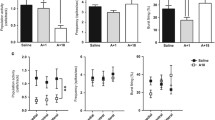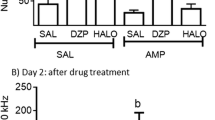Abstract
d-Amphetamine is effective in controlling seizures in petit mal epilepsy. The flash-evoked afterdischarge (FEAD) in rats has been proposed as a model of the petit mal seizure. The experiments reported here investigated the dose response relationship for the suppression of FEAD by d-amphetamine, and compared its effects with those of the dopamine-mimetic, apomorphine. Significant suppression of FEAD was observed at doses of d-amphetamine greater than 0.2 mg/kg. A maximum decrease of 60% occurred at 1.2 mg/kg. Higher doses did not result in any further suppression. In contrast, apomorphine had no effect on the FEAD event at doses that induced intense stereotypic behavior. In other experiments, administration of either the dopamine antagonist pimozide or the α-adrenergic antagonist phenoxybenzamine exacerbated FEAD and also prevented the suppression of FEAD by d-amphetamine. The results of these experiments support the hypothesis that the FEAD is a valid model of the petit mal seizure. Furthermore, they provide evidence that norepinephrine is necessary for the seizuresuppressant action of d-amphetamine.
Similar content being viewed by others
References
Adams AD, Forrester JM (1968) The position of the rats visual field on the cerebral cortex. Quart J Exp Physiol 53:327–336
Anden NE, Rubenson A, Fuxe K, Hokfelt T (1967) Evidence for dopamine receptor stimulation by apomorphine. J Pharm Pharmacol 19:627–629
Anden NE, Strombom U (1974) Adrenergic receptor blocking agents: Effects on central noradrenaline and dopamine receptors and on motor activity. Psychopharmacologia 38:91–103
Bigler ED, Fleming DE (1976) Pharmacological suppression of photically evoked after-discharges in rats: Incremental dose, hippocampal EEG and behavioral activity correlates. Psychopharmacology 46:73–82
Bigler ED, Fleming DE, Shearer DE (1974) Pharmacological modulation of photically evoked afterdischarge patterns in hooded Long-Evans rats. Bull Psychon Soc 4:179–181
Bigler ED, Fleming DE, Shearer DE (1976) Stabilization of photically evoked after-discharge activity: Control procedures and effects of classical trace conditioning. Behav Biol 16:425–437
Bradley PB, Elkes J (1957) Effects of some drugs on the electrical activity of the brain. Brain 80:77–117
Chen G, Weston JK, Bratton AC Jr (1963) Anticonvulsant activity and toxicity of phensuximide, methsuximide and ethosuximide. Epilesia 4:66–76
Cools AR, van Rossum JM (1976) Excitation mediating and inhibition-mediating dopamine-receptors: A new concept to-wards a better understanding of electrophysiological, biochemical, pharmacological, functional and clinical data. Psychopharmacologia 45:243–254
Ernst AM (1967) Mode of action of apomorphine and dexamphetamine on gnawing compulsion in rats. Psychopharmacologia 10:316–323
Fleming DE, Rhodes LE, Wilson CE, Shearer DE (1972) Time-drug modulations of photically evoked after-discharge patterns. Physiol Behav 8:1045–1049
Frey HH (1964) Note on the interactions of amphetamine with anticonvulsant drugs. Acta Pharmacol Toxicol 21:290–298
Gerald MC, Riffee WH (1973) Acute and chronic effects of d- and l-amphetamine on seizure susceptibility in mice. Eur J Pharmacol 21:323–330
Jansser PAJ, Neimegeers CJE, Schellekens KHL, Dresse, A, Lenarts FN, Pinchard A, Schaper WKA, Van Nueten JM, Verbruggen FJ (1968) Pimozide, a chemically novel, highly potent and orally long-acting neuroleptic drug. Arzneim Forsch 3:261–287
Jenney EH, Pfeiffer CC (1956) The predictable value of anticonvulsant indices. Ann NY Acad Sci 64:679–689
Kadzielawa K (1974) Dopamine receptor in the reward system of the rat. Arch Int Pharmacodyn Ther 209:214–226
Kafi S, Gaillard JM (1976) Brain dopamine receptors and sleep in the rat: Effects of stimulation and blockade. Eur J Pharmacol 38:357–363
Kebabian JW, Calne DB (1979) Multiple receptors for dopamine. Nature 277:93–96
Kelly PH (1977) Drug-induced motor behavior. In: Iversen LL, Iversen SD, Snyder SH (eds) Handbook of Psychopharmacology, Vol. 8, Plenum Press, New York
Kilian M, Frey HH (1972) Central monoamines and convulsive thresholds in mice and rats. Neuropharmacol 12:681–692
Kimura D (1962) Multiple response of the visual cortex of the rat to photic stimulation. Electroencephalogr Clin Neurophysiol 14:115–122
King GA, Burnham WE, Livingston KE (1980) Flash-evoked afterdischarge in rat as a model of the absence seizure: doseresponse studies with therapeutic drugs. Epilepsia (in press)
Krall RL, Penry JK, White BG, Kupferberg HJ, Swinyard EA (1978) Antiepileptic drug development. II. Anticonvulsant drug screening. Epilepsia 19:409–428
Livingston S, Kadji L, Bridge EM (1948) The use of benzedrine and dexedrine sulfate in the treatment of epilepsy. J. Pediat 32:490–494
Myslobodsky M (1976) Petit mal epilepsy. Academic Press, New York, p 218
Rechtschaffen A, Marion L (1964) The effect of amphetamine on the sleep cycle. Electroencephalogr Clin Neurophysiol 16:438–445
Riffee WH, Gerald MC (1976) Effects of amphetamine isomers and CNS catecholamine blockers on seizures in mice. Neuropharmacol 15:677–682
Shearer DE, Fleming DE, Bigler FD, Wilson CE (1974) Suppression of photocally evoked after-discharge bursting following administration of anticonvulsants in waking rats. Pharmacol Biochem Behav 2:839–842
Soroko FE, McKenzie GM (1970) The effects of apomorphine and dexamphetamine on metrazol induced convulsions in the rat and mouse. Pharmacologist 12:253
Strauss H (1944) The effect of mental activity on the incidence of seizures and the electroencephalographic pattern in some epileptics. With remarks on the influence of amphetamine sulfate. Psychosom Med 6:141–145
Swinyard EA (1972) Assay of antiepileptic drug activity in experimental animals. Standard tests. In: Mercier J (ed) Anticonvulsant drugs, Pergamon Press, New York (International Encyclopedia of Pharmacology and Therapeutics, Sect 19, Vol. 1) p 47
Turner TAR, Spencer PSJ (1968) Effect of pretreatment with monoamine oxidase inhibitors of (+)amphetamine on leptazol convulsions in mice and rats. J Pharm Pharmacol 20:Suppl 122S-125S
Winer BI (1963) Statistical principles in experimental design. McGraw Hill, New York, p 90
Wolf HH, Rollins DE, Rowland CR, Reigle TG (1969) The importance of endogenous catecholamines in the activity of some CNS stimulants. Int J Neuropharmacol 8:319–328
Wolf HH, Stock GA (1966) Utllity of two convulsant techniques as indicators of CNS excitability. J Pharm Sci 55:1455–1456
Author information
Authors and Affiliations
Rights and permissions
About this article
Cite this article
King, G.A., Burnham, W.M. Effects of d-amphetamine and apomorphine in a new animal model of petit mal epilepsy. Psychopharmacology 69, 281–285 (1980). https://doi.org/10.1007/BF00433096
Received:
Accepted:
Issue Date:
DOI: https://doi.org/10.1007/BF00433096




